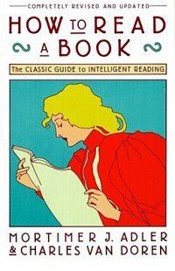How to Read a Book: The Classic Guide to Intelligent Reading

This is a classic instruction manual that does what it says on the cover – it explains the different ways one might read a book.
Specifically, there are four levels:
Elementary Reading
Inspectional Reading (divided into Skimming or Prereading, and Superficial Reading)
Analytical Reading
Synoptical Reading
An interesting thing happens between #3 and #4 – control of the subject transfers to the reader. In #3, the author is pushing information at the reader, who is absorbing it. With #4, the reader is educated enough to know what they want, and they are pulling it from the author.
Along the way there are rules:
You must know what kind of book you are reading, and you should know this as early in the process as possible, preferably before you begin to read
State the unity of the whole book in a single sentence, or at most a few sentences (a short paragraph)
Set forth the major parts of the book, and show how these are organized into a whole, by being ordered to one another and the unity of the whole
Find out what the author’s problems were
Find the important words and through them come to terms with the author
Mark the most important sentences in a book and discover the propositions they contain
Locate or construct the basic arguments in the book by finding them in the connection of sentences
Find out what the author’s solutions are
You must be able to say, with reasonable certainty, “I understand,” before you can say any one of the following things: “I agree” or “I disagree” or “I suspend judgment.”
When you disagree, do so reasonably, and disputatiously, or contentiously
Respect the difference between knowledge and mere personal opinion by giving reasons for any critical judgment you make
Clearly, this is not for the faint of heart, and you’d go mildly insanely trying to apply this to every body.
Another important point, using these rules implies that you trust the author wrote well. Some books are just…not good. They’re written poorly, and any attempt to read them well will likely fail. I can remember some books that would have defied any attempt to apply the above rules to them.
What are my takeaways from this? I don’t know, it’s hard – there’s a lot to remember, and I don’t know that I want to commit to this formal of an investigation or analysis of every book I read.
One thing that did resonate was the idea of “pre-reading” (Rule #1, above). Before you really start reading a book, skim it – read the cover, the acknowledgments, the table of contents, all the chapter heads, etc. Essentially, try to mentally encapsulate the book before starting it, in an attempt to be primed to absorb it better.
There’s also some argument for skimming to be an end in itself. You might skim a book, get the gist of it, and decide you don’t need to actually read it. This is hard for me, because I tend to be obsessive, but it would have enormous value in terms of volume intake.
This is a good book, no doubt. It’s a classic book, but I think it needs to be selectively applied to books into which you’re willing to invest considerable time and emotional energy.
Book Info
- I have read this book. According to my records, I completed it on .
- A hardcover copy of this book is currently in my home library.